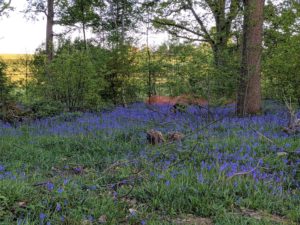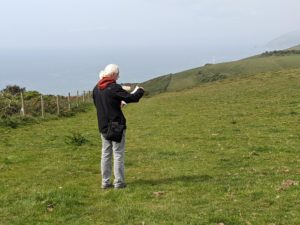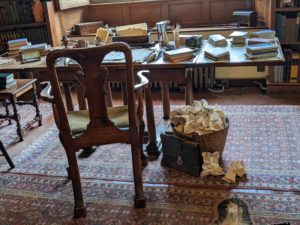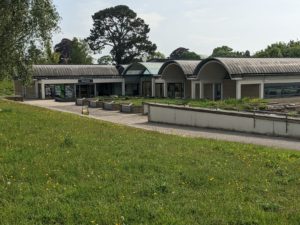Great Days Out

Bluebells in Kent. We got lost on this path and were rescued by friendly locals.
The British have a cheery phrase “great day out” to describe a day away from the work, errands and chores of the big city, a chance to delight one’s eyes, ears and muscles, where the ratio of greenery and nature exceeds that of concrete and glass. Peter and I have just done so, on two separate trips, one to the borders of Devon and Cornwall along the English Channel and one to the gardens and downs of Kent. The trains here, by the way, are efficient and speedy.

The path is not always well marked–just follow the coast line.
The weather was accommodating to our plans: mid to high 60s, blue skies, intermittent puffy clouds, We took a day hike along the South West Coast Path. At 600+ miles, England’s longest footpath includes cliffs and rolling hills as it wends its way entirely around the coasts of Cornwall and Devon, with Somerset and Dorset at either end. We ambled through 7 or 8 miles of it in eastern Cornwall. It was wonderful—part open fields, part forest, all green with spots of blue, white, purple and yellow wildflowers. Also sheep and cows. With babies. And an ancient stone pub for lunch (flying the now-familiar blue and yellow Ukrainian flag).

Part of Vita’s fabulous white garden. My favorite Madame Alfred Carriere climbing rose. I saw it first over 30 years ago, immediately bought one, and it’s still happy in our backyard (although not as well-cared for as Vita’s).
Second bucolic venture was to National Trust gardens in and around Kent. We stayed in a friendly B&B on the Sissinghurst Castle property—amazing.
Then we hired a car and driver to take us to various hinterland corners of Sussex and Kent. First up was Bateman’s, Rudyard Kipling’s family home. The garden was large and clearly designed for the pleasure of the Kipling children, although the volunteer gardeners weren’t happy because the veggie patch had been ravaged the night before by marauding badgers.

Kipling’s desk: note the wadded up pages–typical writer’s desk.
Next we went to Sheffield Park and then Nymans—both large properties with ponds (Sheffield Park), atmospheric gothic houses and a roofless chapel covered in wisteria (Nymans), and lots of trees. Rhodies in wild bloom everywhere (much larger than any in our Arboretum) along with wisteria, early roses, wallflowers, lilacs, and blue bells carpeting the land under the trees. Final stop was Wakehurst, a garden managed by the Kew Garden folks, and also home to the Millennium Seed Bank. The Seed Bank collects, cleans, identifies, tests and stores over 2 billion frozen seeds. It focuses on seeds of endangered varieties that we might need someday (like when the ubiquitous Cavendish banana is wiped out). The display they took to COP26 was set up there and was very good. Plus their labs were all in rooms behind glass so we could see the white-coated scientists at work.

Millennium Seed Bank at Wakehurst.

Forested part of South West Coast path. So wonderful!
Back in London, we’re watching the nest of a pair of seagulls, nestled in amongst the chimney pots of a building next door. They trade off sitting duties. I need to look up how long egg gestation takes. It’s been several weeks now.
A visit to our adopted neighborhood pub enabled us to contemplate a group of entitled Londoner millennials. All white, all in their late 20s, men in suits and ties, women in designer watches and expensive clothes, all drinking and talking loudly, standing at the bar. We asked Archie, our young, hardworking and friendly bartender who they were and why they were there. Turns out they work for the property developer who manages the space the pub and surrounding foodie outlets sit on. They all get 50% off their drinks on certain days and that’s when they show up, Archie said. Once before, he told us, one of them said to him “We’re the reason you have a job.”